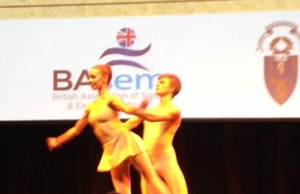Sport and Exercise Medicine: The UK trainee perspective (A BJSM blog series)
By Dr Rebecca Robinson @rjprobinson
1) Before we walk 500 more…
2014 marked the first year of a joint BASEM/FSEM annual conference with the Faculty of Sport and Exercise Medicine. Held in Edinburgh’s Assembly Rooms, the conference was a hub of energy, with attendees ranging from highly experienced sport and exercise physicians to proactive medical students sharing ideas in a strongly supportive atmosphere.
Dr John Maclean’s poignant eulogy for the late Dr Stuart Hillis was a fitting reminder to celebrate excellent mentors. Dr Hillis, a founding father of SEM was posthumously awarded the Sir Roger Bannister Award for outstanding contribution to Sport and Exercise Medicine. Additionally, the award of Honorary Faculty fellowship to Professor Karim Khan reflected his continuing and invaluable contribution to Sports and Exercise Medicine. We are fortunate to have a wealth of experienced and supportive senior physicians in our specialty. As a still-young specialty we are often reminded of the challenges ahead. We may have 500 miles to walk but it was a moment to reflect and thank those who have trail blazed the first 500.
2) Are Elite Athletes any different from the rest of us?
To what degree can we credit genetics in sprint performance, enhance and interpret physiological factors from VO2 max to red cell mass, and just how strong are the upper bodies of world class cyclists compared to weightlifters? Presentations from Professor Yannis Pitsalidis, Dr Barry Fudge, and Calvin Morris provided compelling evidence and raised further questions for research, with one certainty: that world-leading scientific knowledge is providing a performance-enhancing stimulus to elite programmes.
Insights into injuries incurred in golf drew expertise from the medical team attendant at the recent Ryder Cup, led by Dr Roger Hawkes and explained the principles of biomechanics and profiling to an attentive audience. Across the conference, BOSTA (British Orthopaedic Sports Trauma Association and Arthroscopy Association) and BIMM (British Institute of Musculoskeletal Medicine) brought theory behind practice to the table with opportunities for practical sessions.
3) Careers in Sports Medicine
The range of speakers and perspectives in this stream included: NHS, Private and Military Sport and Exercise Physicians. It was valuable for trainees and new consultants at all stages, as they addressed important issues about the scope of future practice from their own depth of experience.
Whilst elite sport offers great opportunities for team involvement, experience, and travel, Dr Phil Batty’s salient advice was a reminder that our foremost duty of care is always to the patient. Align conduct as a Team Physician with your regulatory body’s rules and do not be afraid to stand up for your principles despite perceived pressures.
The mantra to remember was: “You cannot talk yourself out of a situation you’ve behaved yourself into.”
It was a privilege to be treated to the Royal Ballet School’s performances both at the Gala Dinner and demonstrations during the fascinating insights into ballet medicine on Friday morning. Appreciating perhaps one of the most graceful forms of human performance was coupled with insight into the unique challenges of injury, as reported by Drs Ian McCurdie and Philippa Woodward.
The dancers on stage brought to life the focus of the morning session; perhaps if we can be ‘more dancer’ in our approach to our own work and in our perceptions of patients’ potential, we can surpass expectation.
5) ‘Exercise-The Way Forward’
The mandate for physical activity as medicine has never been greater. There is strong evidence that cardiorespiratory fitness reduces mortality in chronic disease, benefits health independent of BMI, and enhances surgical recovery. In the final day session, Dr Harry Burns urged delegates to work together to ‘join the dots’ on promoting and implementing ’physical activity as medicine’. Collaboration between CCGs and hospital specialties are essential, as is work within the wider community to ensure integrated environmental and social policy – vital to supporting wellbeing. It is time to incorporate physical activity into every consultation. Investment in lifelong physical activity promotion for patients from early childhood should involve the whole family and continue through to active ageing. Programmes for community-wide education and engagement are necessary to empower, integrate, and mobilise everybody, everyday.
************************************************
Dr Rebecca Robinson is currently an ST6 in Sports and Exercise Medicine Based in Sheffield, working with GB Boxing, Swimming and Team England at the 2014 Commonwealth Games. She is currently competing for GB in Mountain Running. Twitter: @rjprobinson

